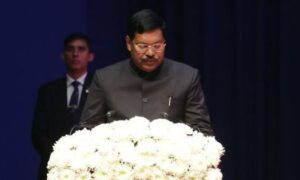
For centuries, the eternal wonder surrounding the stars and planets in the heavens helped nurture thoughts about the possibility of human space travel. Thus, in the 20th century, when the Sputnik satellite was launched by the Soviet Union in 1959, it was the first foray into space. As the world watched closely, the politico-ideological Cold War rivalry between the two superpowers triggered the competition to prove their technological superiority. When Yuri Gagarin became the first human in space by orbiting the earth in the Vostok 1 capsule in April 1961, and Alan Shepard of the US followed suit less than a month later in the Mercury spacecraft, the race for space had officially begun. In the 21st century, with the enormous progress and potential in the space-related fields of science, technology, economy and military, it has become a major arena for showcasing national prowess and geopolitical power. Though many nations – including India – have emerged as serious stakeholders, China is committed to replacing the US as the dominant player, if not the hegemon of the tiān táng or heavens. In the absence of international policies and regulatory mechanisms to ensure peace, the militarisation of space has already begun with the increasing contestation in the guise of national security interests and geopolitical leveraging. The future space security outlook and strategies of Beijing and Washington seem to have crossed the point of no return.
China’s space aspirations began with Mao Zedong’s “Two Bombs One Satellite” goal formulated way back in 1958. However, space was put on the back burner during the Cultural Revolution, and it was only in 1978, with Deng Xiaoping in office that China’s space programme was revived. In 1955, Qian Xuesen, who was a leading scientist in America’s space endeavours, was deported back to China. He came to be considered the “Father of China’s Missile and Space Programme”, and was pivotal in the negotiations with the Soviet Union for the development of nuclear weapons and the “agreement on Moscow’s assistance in the construction of civil and military facilities.”
Between the years 1953 and 1957, the Soviets signed several agreements of industrial support as part of a five-year plan. While this helped to establish the industrial base of China, Mao Zedong was keen on developing self-reliance and considered their continued reliance on the Soviets “unacceptable”. As the political differences between the Soviet Union and China widened, Enlai Zhou and some other leaders who were convinced about the continued need for Soviet support, sought more industrial, technical and scientific assistance, especially for national defence and manufacturing. “During the early 1960s, the tensions between the two Communist Parties erupted into a public controversy so serious that it damaged the alliance between the two countries and disrupted all technology transfer efforts.” This divergence led to the withdrawal of 1,400 Soviet technicians from the PRC and the cancellation of some 200 important joint scientific projects.
Soon after, China tested its ballistic missile in 1960, its nuclear weapon in 1964 and successfully tested the Dongfeng-2 medium-range ballistic missile carrying a nuclear warhead in 1966. In 1970, it launched the heaviest satellite of its time, the Dongfanghong-1, to become the fifth nation in the world to launch a satellite after the USSR, the US, France and Japan. The Richard Nixon-era détente between the US and China initiated by Henry Kissinger in 1971 was followed by the normalisation of diplomatic relations and the signing of the Cooperation in Science and Technology Agreement in 1979. This opened the window for Sino-European cooperation in science and space research, enabling China to launch its first intercontinental ballistic missile in 1980, followed by geosynchronous satellites in the mid-1980s. China thus established itself as a telecommunications satellite manufacturer and, with increasing reliability of its rockets, became an affordable commercial launch partner for a series of international space cooperation efforts.
The turn of the century saw China develop its Shenzhou series of space crafts and in 2003, with Chinese cosmonaut Colonel Yang Liwei of the People’s Liberation Army Air Force carrying out fourteen orbits around Earth, it became the third nation to put a man independently into space. In 2007, it launched the Chang’e-1 lunar orbital spacecraft and also successfully tested its anti-satellite weapon capability when it destroyed a defunct satellite with a ballistic missile. More recently in 2019, China’s Chang’e lunar probe landed on the “far side” of the moon, followed by the landing of Zhurong rover on Mars.
By 2021, China had commenced the construction of its “Tiangong” space station or “Heavenly Palace”, which was declared operational when the three “Taikonauts” or astronauts replaced the construction crew in the space station in November 2022. Since the US law bans the National Aeronautics and Space Administration (NASA) from sharing data with China and prohibits Chinese astronauts from using the International Space Station (ISS), while a Chinese space station would possibly have been a long-term goal, the exclusion triggered the Chinese to expedite their indigenous programme. It expects the Tiangong to replace the ISS, which is due for decommissioning in 2031. With six docking ports, the Tiangong is expected to permit not only the docking of commercial spacecraft but also enable tourist visits in the future. Therefore, China’s three decades of totally indigenous efforts underscore the country’s self-reliance policy and endeavours, and have set the stage for its future ambitions in space. The enviable range and pace of its achievements can be measured from the following milestones:
-
The completion and operation of the BeiDou Navigation Satellite System.
-
The high-resolution earth observation system.
-
The conclusion of the three-step (orbit, land and return) lunar exploration programme.
-
Initiation of the space station.
-
Reaching the mars orbit by Tianwen-1 and successful landing by Zhurong rover on the red planet.
-
Becoming the first country to establish a state-funded space-based solar power (SBSP) base plant.
Other significant achievements include:
-
The Zhuque-210 became the first liquid oxygen- and liquid methane (Methalox)-fuelled rocket to reach orbit.
-
Planned launch of an extension module to upgrade the configuration and capacity of the space station.
-
The Long March 9 super heavy reusable rocket transportation system and 13,000-satellite constellation of the Guo Wang network, which seeks to be the long-run game changer to the unprecedented challenge Elon Musk’s SpaceX has presented before China.
From a totally state-owned enterprise, the rapid transformation and leaps in space endeavours occurred in 2014, when China’s National Development and Reform Commission published ‘Document 60’ to open the doors for the commercialisation of its enterprise in space. According to Statista Research Department, the government expenditure on space in 2022 has the US leading with US $61.97 billion, followed by China at almost $11.94 billion and India at $1.93 billion. When it comes to Chinese commercial space firms, the investments are expected to exceed $4.7 billion. Fuelled by an ever-rising demand for its commercial launch services, China expects to launch a staggering 4,000 satellites over the next decade, from the 400 currently in orbit. As per a 2021 US National Intelligence assessment, “2030 Chinese space activities will increasingly erode the national security, commercial, and global influence advantages that the United States has accrued from its leadership in space”. The report also expects that China will continue to leverage its non-military and commercial space activities to expand its global influence. Its ambition to be the world leader by 204515 is, however, not without its challenges.
The situation is not as rosy as projected, since despite the large demand and ample government support, the Chinese commercial space enterprise is not an easy market to access. This is essentially due to the contradiction that even though the government and industry are calling for international cooperation, the former is also simultaneously calling for greater production within the country. In the US, the absence of adequate regulatory space laws and policies allows private players like Elon Musk’s SpaceX to achieve what it has. But in China, commercial enterprises cannot compete with the big state-owned China Aerospace Science and Technology Corporation (CASC) and the China Aerospace and Science Industry Corporation (CASIC), with their vast array of subordinate R&D, production complexes and specialised companies.
However, in recent years, at the smaller-scale end of manufacturing, 200 commercial space companies have been created with an outlay of ¥33 billion and the active support of the state-owned sector. Chinese start-ups are expanding at a rapid pace with commercial companies focusing on very specific technologies and partnering with foreign space-tech companies.
China has twenty-five launch companies today, which enable satellite launches at a faster rate than other countries. Spacety –a commercial satellite manufacturer in partnership with several European component manufacturers – launches small satellites very regularly and competitively. Compared to the wait of over twelve to eighteen months for a European launch slot, Spacety offers one within three months.16 The rapid proliferation of the commercial space sector driven by development and advances in science and technology, is a sign of the salience given to space as the domain of the future. But China’s engagement with space is much more than a venture for mere economic prosperity. It is the very pivot of its global leadership ambitions, and a long-term strategy is clearly at work.
Excerpted with permission from ‘Contest for the Heavens China’s Space Programme’ by Diptendu Choudhury in Decoding China: Hard Perspectives From India, edited by Ashok K Kantha, Bloomsbury India.
📰 Crime Today News is proudly sponsored by DRYFRUIT & CO – A Brand by eFabby Global LLC
Design & Developed by Yes Mom Hosting






